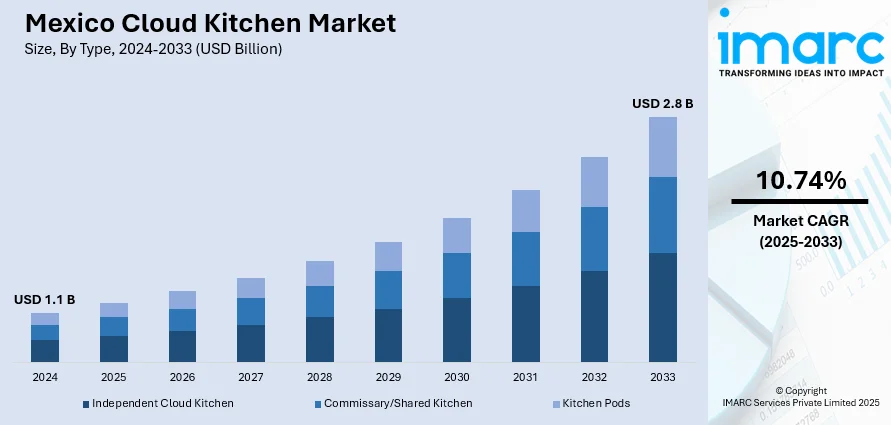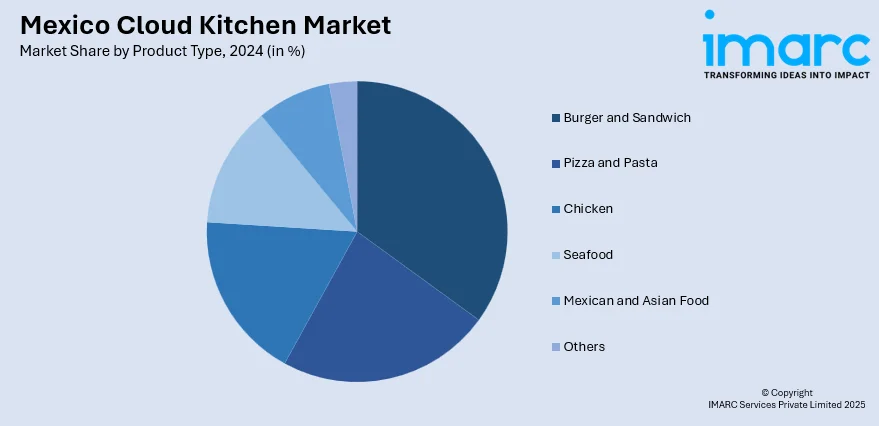
Mexico Cloud Kitchen Market Size, Share, Trends and Forecast by Type, Product Type, Nature, and Region, 2025-2033
Mexico Cloud Kitchen Market Overview:
The Mexico Cloud Kitchen Market size reached USD 1.1 Billion in 2024. Looking forward, IMARC Group expects the market to reach USD 2.8 Billion by 2033, exhibiting a growth rate (CAGR) of 10.74% during 2025-2033. The growing need for convenient, home-delivered meals, driven by the increasingly hectic pace of urban life and a rising preference among consumers for online food ordering is significantly contributing to the expansion of the cloud kitchen market in Mexico. Furthermore, this trend is encouraging food entrepreneurs to adopt the cloud kitchen model, which offers reduced operational costs and greater flexibility compared to traditional dine-in restaurants.
|
Report Attribute
|
Key Statistics
|
|---|---|
|
Base Year
|
2024
|
|
Forecast Years
|
2025-2033
|
|
Historical Years
|
2019-2024
|
| Market Size in 2024 | USD 1.1 Billion |
| Market Forecast in 2033 | USD 2.8 Billion |
| Market Growth Rate 2025-2033 | 10.74% |
Mexico Cloud Kitchen Market Trends:
Expansion of Virtual Brands and Multi-Brand Kitchens Models
The emergence of virtual brands is reshaping the Mexico cloud kitchen market outlook. Operators are increasingly creating multiple delivery-only food concepts under a single kitchen infrastructure. These virtual brands allow businesses to diversify their offerings and cater to various consumer preferences without investing in separate physical locations. A single kitchen may serve Mexican cuisine, Asian fusion, and fast food all under different brand names. This strategy enhances operational efficiency, allowing businesses to swiftly respond to changing market demands and optimize resource utilization. By experimenting with different menus and concepts, businesses can better engage niche audiences while reducing operational risks. Multi-brand models' adaptability and scalability are facilitating quick growth and giving businesses a competitive edge in Mexico's changing food delivery market.

Emphasis on Kitchen Automation and Digital Management
Cloud kitchens in Mexico are swiftly embracing advanced technology to enhance operational efficiency and reduce reliance on manual labor. In line with global trends where 25% of cloud kitchens are expected to adopt robotic technology and automation by 2024 Mexican operators are implementing automated kitchen tools, digital inventory systems, and AI-powered analytics. These technologies support accurate demand forecasting, precise ingredient management, and quicker food preparation, all crucial for the fast-paced nature of food delivery. Automation ensures consistent food quality, reduces human error, and boosts customer satisfaction. Integrated platforms offer real-time monitoring of performance and cost metrics, helping businesses track profitability more effectively. This technological shift allows cloud kitchens in Mexico to scale operations swiftly while maintaining uniform standards of service and food quality across multiple locations, strengthening their competitive edge further aiding the Mexico cloud kitchen market share.
Deepening Integration with Food Delivery Platforms
Cloud kitchens in Mexico are becoming increasingly integrated with digital food delivery platforms, transforming how food is ordered and delivered. By relying on these apps for logistics and customer acquisition, cloud kitchens can focus entirely on food production. This synergy offers significant advantages, including faster order fulfillment and broader market reach. With seamless order tracking, real-time updates, and customer feedback loops, these platforms enhance the dining experience without the need for physical storefronts. Delivery apps also offer valuable consumer behavior insights that help cloud kitchens refine their menus and marketing strategies. As a result, the close alignment between cloud kitchens and delivery platforms is driving efficiency, enhancing visibility, and reinforcing the convenience-centric model favored by today’s urban consumers.
Mexico Cloud Kitchen Market Segmentation:
IMARC Group provides an analysis of the key trends in each segment of the market, along with forecasts at the region level for 2025-2033. Our report has categorized the market based on type, product type and nature.
Type Insights:
- Independent Cloud Kitchen
- Commissary/Shared Kitchen
- Kitchen Pods
The report has provided a detailed breakup and analysis of the market based on the type. This includes independent cloud kitchen, commissary/shared kitchen, and kitchen pods.
Product Type Insights:

- Burger and Sandwich
- Pizza and Pasta
- Chicken
- Seafood
- Mexican and Asian Food
- Others
A detailed breakup and analysis of the market based on the product type have also been provided in the report. This includes burger and sandwich, pizza and pasta, chicken, seafood, Mexican and Asian food, and others.
Nature Insights:
- Franchised
- Standalone
The report has provided a detailed breakup and analysis of the market based on the nature. This includes franchised, and standalone.
Regional Insights:
- Northern Mexico
- Central Mexico
- Southern Mexico
- Others
The report has also provided a comprehensive analysis of all the major regional markets, which include Northern, Central, Southern Mexico, and others.
Competitive Landscape:
The market research report has also provided a comprehensive analysis of the competitive landscape. Competitive analysis such as market structure, key player positioning, top winning strategies, competitive dashboard, and company evaluation quadrant has been covered in the report. Also, detailed profiles of all major companies have been provided.
Mexico Cloud Kitchen Market News:
- In February 2025, Alibaba Cloud officially launched its first cloud region in Mexico, located in Querétaro, less than a year after announcing its expansion plans. The new region, featuring one availability zone, marks Alibaba’s commitment to supporting local businesses with advanced cloud services. The company aims to build a collaborative ecosystem in Mexico, enabling businesses to innovate and leverage Alibaba’s global network, particularly to access markets across Asia and beyond.
Mexico Cloud Kitchen Market Report Coverage:
| Report Features | Details |
|---|---|
| Base Year of the Analysis | 2024 |
| Historical Period | 2019-2024 |
| Forecast Period | 2025-2033 |
| Units | Billion USD |
| Scope of the Report |
Exploration of Historical Trends and Market Outlook, Industry Catalysts and Challenges, Segment-Wise Historical and Future Market Assessment:
|
| Types Covered | Independent Cloud Kitchen, Commissary/Shared Kitchen, Kitchen Pods |
| Product Types Covered | Burger and Sandwich, Pizza and Pasta, Chicken, Seafood, Mexican and Asian Food, Others |
| Natures Covered | Franchised, Standalone |
| Regions Covered | Northern Mexico, Central Mexico, Southern Mexico, Others |
| Customization Scope | 10% Free Customization |
| Post-Sale Analyst Support | 10-12 Weeks |
| Delivery Format | PDF and Excel through Email (We can also provide the editable version of the report in PPT/Word format on special request) |
Key Questions Answered in This Report:
- How has the Mexico cloud kitchen market performed so far and how will it perform in the coming years?
- What is the breakup of the Mexico cloud kitchen market on the basis of type?
- What is the breakup of the Mexico cloud kitchen market on the basis of product type?
- What is the breakup of the Mexico cloud kitchen market on the basis of nature?
- What is the breakup of the Mexico cloud kitchen market on the basis of region?
- What are the various stages in the value chain of the Mexico cloud kitchen market?
- What are the key driving factors and challenges in the Mexico cloud kitchen market?
- What is the structure of the Mexico cloud kitchen market and who are the key players?
- What is the degree of competition in the Mexico cloud kitchen market?
Key Benefits for Stakeholders:
- IMARC’s industry report offers a comprehensive quantitative analysis of various market segments, historical and current market trends, market forecasts, and dynamics of the Mexico cloud kitchen market from 2019-2033.
- The research report provides the latest information on the market drivers, challenges, and opportunities in the Mexico cloud kitchen market.
- Porter's five forces analysis assist stakeholders in assessing the impact of new entrants, competitive rivalry, supplier power, buyer power, and the threat of substitution. It helps stakeholders to analyze the level of competition within the Mexico cloud kitchen industry and its attractiveness.
- Competitive landscape allows stakeholders to understand their competitive environment and provides an insight into the current positions of key players in the market.
Need more help?
- Speak to our experienced analysts for insights on the current market scenarios.
- Include additional segments and countries to customize the report as per your requirement.
- Gain an unparalleled competitive advantage in your domain by understanding how to utilize the report and positively impacting your operations and revenue.
- For further assistance, please connect with our analysts.
 Request Customization
Request Customization
 Speak to an Analyst
Speak to an Analyst
 Request Brochure
Request Brochure
 Inquire Before Buying
Inquire Before Buying




.webp)




.webp)












